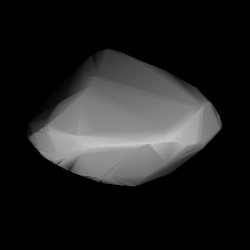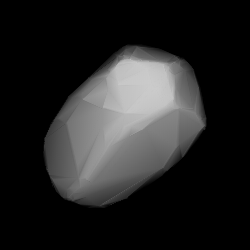
2829 Bobhope is a dark asteroid of the Meliboea family, from the outer region of the asteroid belt. It was discovered on 9 August 1948, by South African astronomer Ernest Leonard Johnson at Union Observatory in Johannesburg. The asteroid was later named after comedian Bob Hope. The asteroid has a rotation period of 6.1 hours and measures approximately 37 kilometers in diameter.
Athalia, provisional designation 1903 ME, is a carbonaceous Themistian asteroid from the outer regions of the asteroid belt, approximately 40 kilometers in diameter. It was discovered on 20 September 1903, by German astronomer Max Wolf at the Heidelberg Observatory in southwest Germany. The asteroid was named after the ancient Judahite queen Athaliah.
606 Brangäne, provisional designation 1906 VB, is an asteroid from the central regions of the asteroid belt, approximately 36 kilometers in diameter. It was discovered on 18 September 1906, by astronomer August Kopff at the Heidelberg Observatory in southwest Germany. The unusual K-type asteroid is the namesake of the small Brangäne family and has a rotation period of 12.3 hours. It was named after Brangaine, a character from the opera Tristan und Isolde by Richard Wagner.
997 Priska, provisional designation 1923 NR, is a carbonaceous Adeonian asteroid from the central regions of the asteroid belt, approximately 19 kilometers in diameter. It was discovered on 12 July 1923, by astronomer Karl Reinmuth at the Heidelberg-Königstuhl State Observatory in southwest Germany. The asteroid's name is a common German female name, unrelated to the discoverer's contemporaries.
1766 Slipher, provisional designation 1962 RF, is a Paduan asteroid from the central regions of the asteroid belt, approximately 18 kilometers in diameter. It was discovered on 7 September 1962, by astronomers of the Indiana Asteroid Program at Goethe Link Observatory in Indiana, United States. The asteroid was named after American astronomers Vesto Slipher and his brother Earl C. Slipher.

1073 Gellivara, provisional designation 1923 OW, is a dark Themistian asteroid, approximately 27 kilometers in diameter, located in the outer regions of the asteroid belt. It was discovered by Austrian astronomer Johann Palisa at the Vienna Observatory on 14 September 1923, and later named after the Swedish town of Gällivare.
1120 Cannonia, provisional designation 1928 RV, is a stony Florian asteroid from the inner regions of the asteroid belt, approximately 10 kilometers in diameter. Discovered by Pelageya Shajn at Simeiz in 1928, it was named after American astronomer Annie Jump Cannon.
1128 Astrid, provisional designation 1929 EB, is a carbonaceous Astridian asteroid from the central region of the asteroid belt. It is the parent body of the Astrid family and measures approximately 40 kilometers in diameter.
11277 Ballard, provisional designation 1988 TW2, is a Phocaea asteroid from the inner regions of the asteroid belt, approximately 6.3 kilometers (3.9 miles) in diameter. It was discovered on 8 October 1988, by American astronomer couple Carolyn and Eugene Shoemaker at the Palomar Observatory in California. The assumed S-type asteroid has a rotation period of at least 10 hours. It was named for American marine scientist Robert Ballard.
9298 Geake, provisional designation 1985 JM, is a Mitidika asteroid from the central regions of the asteroid belt, approximately 12 kilometers in diameter. It was discovered on 15 May 1985, by American astronomer Edward Bowell at Lowell Observatory's Anderson Mesa Station near Flagstaff, Arizona, United States. The asteroid was named for British astronomer John E. Geake.
3031 Houston, provisional designation 1984 CX, is a stony Florian asteroid from the inner regions of the asteroid belt, approximately 6 kilometers in diameter. It was discovered on 8 February 1984, by American astronomer Edward Bowell at Anderson Mesa Station near Flagstaff, Arizona. It was named after American amateur astronomer Walter Scott Houston.
4944 Kozlovskij, provisional designation 1987 RP3, is a carbonaceous Witt asteroid from the central regions of the asteroid belt, approximately 10 kilometers (6 miles) in diameter. It was discovered on 2 September 1987, by Soviet astronomer Lyudmila Chernykh at the Crimean Astrophysical Observatory in Nauchnij, on the Crimean Peninsula. The asteroid was named for Russian opera singer Ivan Kozlovsky.
3844 Lujiaxi, provisional designation 1966 BZ, is a Henan asteroid from the central regions of the asteroid belt, approximately 15 kilometers in diameter. It was discovered on 30 January 1966, by astronomers at the Purple Mountain Observatory in Nanking, China. The asteroid was named after Chinese chemist Lu Jiaxi.
1303 Luthera, provisional designation 1928 FP, is a dark asteroid and the parent body of the Luthera family, located in the outermost regions of the asteroid belt. It measures approximately 90 kilometers in diameter. The asteroid was discovered on 16 March 1928, by astronomer Friedrich Schwassmann at the Bergedorf Observatory in Hamburg, Germany, and later named after German astronomer Robert Luther.
1306 Scythia, provisional designation 1930 OB, is a dark Ursula asteroid from the outer regions of the asteroid belt, approximately 72 kilometers in diameter. It was discovered on 22 July 1930, by Soviet astronomer Grigory Neujmin at the Simeiz Observatory on the Crimean peninsula. The asteroid was named for the historic region of Scythia.
2882 Tedesco, provisional designation 1981 OG, is a Themistian asteroid from the outer regions of the asteroid belt, approximately 22 kilometers in diameter. It was discovered on 26 July 1981, by astronomer Edward Bowell at the Anderson Mesa Station near Flagstaff, Arizona. The likely elongated C-type asteroid has a rotation period of 19.8 hours. It was named for American astronomer Ed Tedesco.

1189 Terentia, provisional designation 1930 SG, is a carbonaceous Terentian asteroid from the outer regions of the asteroid belt, approximately 56 kilometers in diameter and the namesake of its family. The asteroid was discovered by Russian astronomer Grigory Neujmin at Simeiz Observatory on 17 September 1930.

1186 Turnera, provisional designation 1929 PL, is a stony Eoan asteroid from the outer regions of the asteroid belt, approximately 36 kilometers in diameter. It was discovered on 1 August 1929, by South African astronomer Cyril Jackson at the Union Observatory in Johannesburg. The asteroid was later named after British astronomer Herbert Hall Turner.
1302 Werra, provisional designation 1924 SV, is a Themistian asteroid from the outer regions of the asteroid belt, approximately 30 kilometers in diameter. It was discovered on 28 September 1924, by German astronomer Karl Reinmuth at the Heidelberg-Königstuhl State Observatory. The asteroid was named for the river Werra in central Germany.

4388 Jürgenstock, provisional designation 1964 VE, is a bright Phocaea asteroid from the inner regions of the asteroid belt, approximately 4.7 kilometers in diameter. It was discovered on 3 November 1964, by astronomers at Indiana University during the Indiana Asteroid Program at Goethe Link Observatory in Indiana, United States. The assumed S-type asteroid has a short rotation period of 2.8 hours and is rather spherical in shape. It was named for German-Venezuelan astronomer Jürgen Stock. In February 2019, the asteroid occulted the brightest star in the night sky, Sirius.





